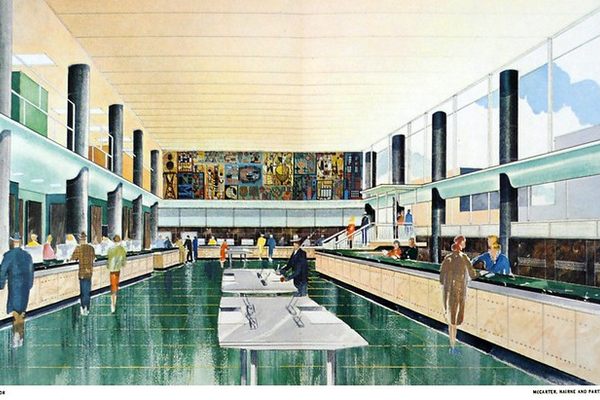About
The Fulton Street Station on New York’s subway system recently benefitted from a 10-year, $1.4 billion overhaul. The centre piece of the MTA’s “Grand Central of Downtown,” which re-opened in November of 2014, was an elaborate “oculus” dome of glass and aluminium, spanning 53-feet in diameter, representing what the MTA grandly called “a metaphor for the celestial heaven.”
As impressive as the giant skylight is, there was quite a remarkable spectacle already in place at Fulton Street Station, hidden away and largely unnoticed at the William Street entrance; the beautiful tile murals that once adorned the walls of the Marine Grill, a grand restaurant located in what was once the world’s largest hotel, the McAlpin.
The Hotel McAlpin was situated in Herald Square, occupying the corner block of 34th Street and Broadway. Opening in 1912 and soaring 25-stories high, the McAlpin had room enough for 2,500 guests. As well as being, at the time, the world’s largest hotel, it was also one of the most luxurious. The amenities on offer to guests were as breathtaking as they were opulent, including a massive giant Turkish bath and plunge pool that occupied the entire 24th floor. The hotel also had its own in-house orchestra, as well as its own fully equipped hospital. Located on the floor below the Turkish bath, patients benefitted from “every modern appliance known to surgery.”
The hotel even had gender specific floors, with newspaper adverts promising that “for unaccompanied women, the entire sixth floor is reserved.” There was even a separate check-in desk staffed by women, so that single female travelers could avoid the approaches of scoundrels in the main lobby.
Such was the attention given to customer service that the entire 16th floor was reserved for night workers so they could sleep during the day; the New York Times christened the floor the “Sleepy Sixteenth.”
These heights of luxury extended to the Marine Grill restaurant located in the basement. Dominated by a forest of archways and columns, the grill room was covered in exquisite tile murals designed by Frederick Dana Marsh. The tiles told the story of the maritime history of New York, and featured elaborate murals of steamships, paddle steamers, and ocean liners from the golden age of Trans-Atlantic voyages.
The 20 murals, fabricated by the Atlantic Terra Cotta Company of Staten Island, spoke to the era when New York was one of the world’s most vibrant, and busiest ports. Covering the entire wall space, they would have looked down on a packed room of patrons dining on lobster and oysters, washed down with Gibson cocktails.
In the 1970s, the grand McAlpin was sold and converted into 700 apartments, which still exist today, under the name Herald Towers. During renovations, the glorious tile murals were simply thrown away. Susan Tunick, president of the non-profit Friends of Terra Cotta, alerted the New York Landmarks Preservation Committee and the tiles were rescued from the dumpsters outside the old hotel. The tiles were then given to the MTA’s Arts for Transit Program, and they were reassembled piece by piece like a giant jigsaw puzzle over one summer by a group of college interns. In 2000 the restored murals were installed in the Fulton Street Station, along with the ornate iron gate that had adorned the entrance to the Marine Grill.
New York may have lost one of its grand old hotels, but subway passengers entering Fulton Street Station by the Williams Street entrance can see a little known remnant of its once luxurious opulence.
Related Tags
Community Contributors
Added By
Published
May 27, 2015




















































